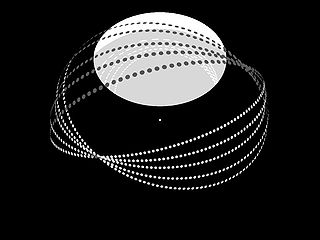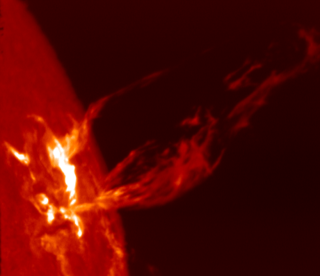
In astronomy and planetary science, a magnetosphere is a region of space surrounding an astronomical object in which charged particles are affected by that object's magnetic field. It is created by a celestial body with an active interior dynamo.

The Sun is the star at the center of the Solar System. It is a massive, nearly perfect sphere of hot plasma, heated to incandescence by nuclear fusion reactions in its core, radiating the energy from its surface mainly as visible light and infrared radiation with 10% at ultraviolet energies. It is by far the most important source of energy for life on Earth. The Sun has been an object of veneration in many cultures. It has been a central subject for astronomical research since antiquity.

The solar wind is a stream of charged particles released from the upper atmosphere of the Sun, called the corona. This plasma mostly consists of electrons, protons and alpha particles with kinetic energy between 0.5 and 10 keV. The composition of the solar wind plasma also includes a mixture of materials found in the solar plasma: trace amounts of heavy ions and atomic nuclei of elements such as carbon, nitrogen, oxygen, neon, magnesium, silicon, sulfur, and iron. There are also rarer traces of some other nuclei and isotopes such as phosphorus, titanium, chromium, and nickel's isotopes 58Ni, 60Ni, and 62Ni. Superimposed with the solar-wind plasma is the interplanetary magnetic field. The solar wind varies in density, temperature and speed over time and over solar latitude and longitude. Its particles can escape the Sun's gravity because of their high energy resulting from the high temperature of the corona, which in turn is a result of the coronal magnetic field. The boundary separating the corona from the solar wind is called the Alfvén surface.

The solar mass (M☉) is a standard unit of mass in astronomy, equal to approximately 2×1030 kg. It is approximately equal to the mass of the Sun. It is often used to indicate the masses of other stars, as well as stellar clusters, nebulae, galaxies and black holes. This equates to about two nonillion (short scale), two quintillion (long scale) kilograms or 2000 quettagrams:

T Tauri stars (TTS) are a class of variable stars that are less than about ten million years old. This class is named after the prototype, T Tauri, a young star in the Taurus star-forming region. They are found near molecular clouds and identified by their optical variability and strong chromospheric lines. T Tauri stars are pre-main-sequence stars in the process of contracting to the main sequence along the Hayashi track, a luminosity–temperature relationship obeyed by infant stars of less than 3 solar masses (M☉) in the pre-main-sequence phase of stellar evolution. It ends when a star of 0.5 M☉ or larger develops a radiative zone, or when a smaller star commences nuclear fusion on the main sequence.

A stellar wind is a flow of gas ejected from the upper atmosphere of a star. It is distinguished from the bipolar outflows characteristic of young stars by being less collimated, although stellar winds are not generally spherically symmetric.

The Cat's Eye Nebula is a planetary nebula in the northern constellation of Draco, discovered by William Herschel on February 15, 1786. It was the first planetary nebula whose spectrum was investigated by the English amateur astronomer William Huggins, demonstrating that planetary nebulae were gaseous and not stellar in nature. Structurally, the object has had high-resolution images by the Hubble Space Telescope revealing knots, jets, bubbles and complex arcs, being illuminated by the central hot planetary nebula nucleus (PNN). It is a well-studied object that has been observed from radio to X-ray wavelengths.

A coronal mass ejection (CME) is a significant ejection of magnetic field and accompanying plasma mass from the Sun's corona into the heliosphere. CMEs are often associated with solar flares and other forms of solar activity, but a broadly accepted theoretical understanding of these relationships has not been established.
Aeolian commonly refers to things related to either of two Greek mythological figures:

In astrophysics, a bow shock occurs when the magnetosphere of an astrophysical object interacts with the nearby flowing ambient plasma such as the solar wind. For Earth and other magnetized planets, it is the boundary at which the speed of the stellar wind abruptly drops as a result of its approach to the magnetopause. For stars, this boundary is typically the edge of the astrosphere, where the stellar wind meets the interstellar medium.

Stellar engines are a class of hypothetical megastructures which use the resources of a star to generate available work. For instance, they can use the energy of the star to produce mechanical, electrical or chemical work or they can use the impulse of the light emitted by the star to produce thrust, able to control the motion of a star system. The concept has been introduced by Bădescu and Cathcart. The variants which produce thrust may accelerate a star and anything orbiting it in a given direction. The creation of such a system would make its builders a type-II civilization on the Kardashev scale.
Wind is the movement of air.

Stellar mass loss is a phenomenon observed in stars by which stars lose some mass over their lives. Mass loss can be caused by triggering events that cause the sudden ejection of a large portion of the star's mass. It can also occur when a star gradually loses material to a binary companion or due to strong stellar winds. Massive stars are particularly susceptible to losing mass in the later stages of evolution. The amount and rate of mass loss varies widely based on numerous factors.
Solar wind is a stellar phenomenon of the Sun

A stellar magnetic field is a magnetic field generated by the motion of conductive plasma inside a star. This motion is created through convection, which is a form of energy transport involving the physical movement of material. A localized magnetic field exerts a force on the plasma, effectively increasing the pressure without a comparable gain in density. As a result, the magnetized region rises relative to the remainder of the plasma, until it reaches the star's photosphere. This creates starspots on the surface, and the related phenomenon of coronal loops.

A stellar-wind bubble is a cavity light-years across filled with hot gas blown into the interstellar medium by the high-velocity stellar wind from a single massive star of type O or B. Weaker stellar winds also blow bubble structures, which are also called astrospheres. The heliosphere blown by the solar wind, within which all the major planets of the Solar System are embedded, is a small example of a stellar-wind bubble.
Super flare may refer to:

The Alfvén surface is the boundary separating a star's corona from the stellar wind defined as where the coronal plasma's Alfvén speed and the large-scale stellar wind speed are equal. It is named after Hannes Alfvén, and is also called Alfvén critical surface, Alfvén point, or Alfvén radius. In 2018, the Parker Solar Probe became the first spacecraft that crossed Alfvén surface of the Sun.












